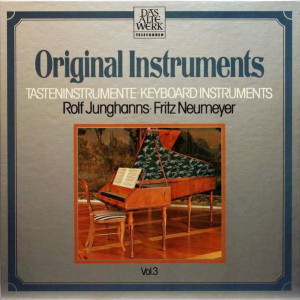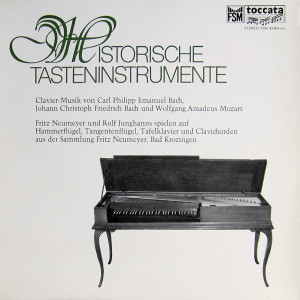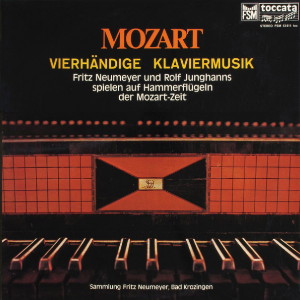 |
3 LP's
- Telefunken 6.35576 EK (p) 1981
|
 |
| 1 LP -
Toccata FSM 43 604 (p) 1975 |
 |
| 1 LP -
Toccata FSM 53 611 (p) 1975 |
|
| ORIGINALINSTRUMENTE -
Tasteninstrumente Vol. 3 |
|
|
|
|
|
|
|
|
Long Playing 1
|
|
|
|
| Carl Philipp Emanuel Bach
(1714-1788) |
12
Variationen über "Les folies
d'Espagne", Wq 118 *
|
|
10' 10" |
A1 |
| Johann Christoph
Friedrich Bach (1732-1795) |
14
Variationen über "Ah, vous
dirai-je Maman", Wohlf. Verz. XII,
2 ** |
|
9' 14" |
A2 |
| Wolfgang
Amadeus Mozart (1756-1791)
|
Rondo
D-dur, KV 485 ***
|
|
5' 21" |
A3 |
| Carl Philipp Emanuel Bach |
Rondo
III - aus "Clavier-Sonaten
nebst einigen Rondos fürs
Fortepiano, für Kenner und
Liebhaber, Zweyte Sammlung", Wq 56 °
|
|
9' 35" |
B1 |
|
Sonata
III - aus "Clavier-Sonaten
nebst einigen Rondos fürs
Fortepiano, für Kenner und
Liebhaber, Zweyte Sammlung", Wq 56 ° |
|
6' 33" |
B2 |
| Wolfgang Amadeus Mozart |
Sonate
C-dur, KV 545 |
|
12' 42" |
B3 |
|
-
Allegro · Andante · Rondo:
Allegretto |
|
|
|
|
Long Playing 2 |
|
|
|
| Wolfgang Amadeus Mozart |
Sonate
D-dur, KV 381 +
|
|
14' 50" |
C1 |
|
-
Allegro · Andante · Allegro
molto |
|
|
|
|
Andante
G-dur mit fünf Variationen, KV 501
++
|
|
8' 50" |
C2 |
|
Sonate
C-dur, KV 521 +++
|
|
23' 30" |
D1 |
|
-
Allegro · Andante ·
Allegretto |
|
|
|
|
Long Playing 3 |
|
|
|
| Wilhelm Friedemann Bach (1710-1784) |
Acht
Fugen für Cembalo *
|
|
17' 10" |
E1 |
|
-
(Allegro moderato) · (Presto) ·
Adagio · Allegro |
|
|
|
| Johann Abraham Peter
Schulz (1747-1800) |
Allegretto
Nr. 5 - aus "Sechs
Klavierstücke", Op. 1 **
|
|
5' 40" |
E2 |
| Johann Christian Bach
(1735-1782) |
Sonate
B-dur, Op. 17 Nr. 6 ***
|
|
18' 45" |
F1 |
|
-
Allegro |
6' 13" |
|
|
|
-
Andante |
8' 20" |
|
|
|
-
Prestissimo |
4' 12" |
|
|
| Wolfgang Amadeus
Mozart |
Fantasie
d-moll, KV 397 ****
|
|
6' 10" |
F2 |
|
|
|
|
|
Rolf
JUNGHANNS */**/***
|
Fritz
NEUMEYER
|
|
Fritz
NEUMEYER °/°°
|
Rolf JUNGHANNS
|
Rolf
JUNGHANNS
|
|
|
|
(Long Playing 1)
|
(Long Playing 2)
|
(Long Playing 3) |
-
Tangentenflügel von Späth &
Schmahl, Regensburg 1801 *
|
-
Hammerflügel, unsigniert,
süddeutsch um 1780 +
|
-
Cembalo nach Blanchet, Paris um
1730, von Willard Martin,
Bethlehem/Pennsylvania *
|
| -
Tafelklavier, sog. Clavecin Royale
von Gottlob Wagner, Dresden 1785
** |
-
Hammerflügel von Joh. André Stein,
Augsburg um 1785 ++
|
-
Hammerflügel von Matthäus
Heilmann, Mainz um 1785
**/**** |
| -
Hammerflügel, unsigniert (Matthäus
Heilmann, Mainz?), um 1780 1785
*** |
-
Hammerflügel von Johann Gottlieb
Fichtl, Wien um 1795 +++
|
-
Hammerflügel von John Broadwood
& Son, London 1798 ***
|
| -
Bundfreies Clavichord von Carl
Schmahl, Regensburg?, Ende 18.
Jahrh. ° |
(Instrumente
restauriert von Rudolf Dobernecker)
+ /++ |
|
| -
Gebundene Clavichord, unsigniert,
süddeutsch um 1800 °° |
(Instrument
restauriert von Martin Scholz) +++
|
|
| (Alle Instrumente
wurden restauriert von Rudolf Dobernecker,
Freiburg) |
|
|
|
|
|
|
Luogo
e data di registrazione |
|
Schlos
Bad Krozingen (Germania) - 1975
(long playing 1 & 2) |
|
|
Registrazione:
live / studio |
|
studio |
|
|
Recording
Supervision
|
|
Paul
Dery |
|
|
Edizione LP |
|
TELEFUNKEN
- 6.35576 EK - (3 LP's - durata
53' 35", 47' 10" & 47' 55") -
(p) 1975/81 |
|
|
Originale LP
|
|
TOCCATA
- FSM 43 604 - (1 LP - durata
53' 35") - (p) 1975 -
Analogico (long playing 1)
TOCCATA - FSM 53 611 - (1 LP -
durata 47' 10") - (p) 1975 -
Analogico (long playing 2)
TELEFUNKEN - 6.35576 EK - (3°
LP - durata 47' 55") - (p)
1981 - Analogico (long playing
3)
|
|
|
Prima Edizione CD |
|
-
|
|
|
Note |
|
Production
by Toccata.
|
|
|
|
|
Keyboard
Music about
1780
Keyboard
music circa 1780
is characterized
by the
simultaneous
existence of a
number of
different styles.
The galant
style, inspired by
the French
intellect, took on
its subjective
animation from
German
"sentimentality"
and, by way of
integrating with
the arioso
and buffo
elements of the
Italian style,
flowed into
Mozartean
classicism - a
process which,
above all,
characterized the
work of the sons
of J. S. Bach. The
multiplicity of
styles in
existence in the
1770s and 1780s
did not only
influence the
actual composition
of keyboard music,
it also affected
the construction
of the instruments
themselves.
Harpsichord,
fortepiano,
clavichord, square
piano and a
strange hybrid
like the so-called
"tangential"
clavichord all
existed alongside
each other. The
allocation of
instrument was
left to individual
good taste -
always the
ultimate arbiter
in the 18th
century.
The "Folia", also
called "Les folies
d’Espagne" since
the 17th century,
is a melodic model
which has been
used by many
composers as a
melodic and
harmonic framework
for the
composition of
variations. Carl
Philipp Emanuel
Bach wrote his
twelve variations
on the "Folies" in
1778. The opulence
of the rhythmic,
harmonic, dynamic
and even
polyphonic
variation devices
which Bach employs
are without
parallel for their
time. Each of the
twelve variations
seems to be a
quite individual,
musically
independent
version of the
basic theme, yet
the impression of
unbroken, cyclical
unity is kept
intact.
In about 1785,
Emanuel’s younger
brother Johann
Christoph
Friedrich Bach
wrote a set of
variations on the
French song "Ah,
vous dirai-je
Maman", which was
universally
popular at the
time. In contrast
to the "Folies"
variations, J. C.
F. Bach’s work
represents a less
exacting variation
model, intended
for performance by
the amateur
music-lover. In
the fourteen
pieces, most of
which are written
for two parts, the
variations on the
song melody are
principally
achieved by
figurations to the
upper part which
conform throughout
to a
characteristic
pattern. This
cycle seems today
to be a
particularly
delightful example
of the art of late
18th century
society.
Mozart’s D-major
Rondo K. 485,
which he wrote in
1787, and the
C-major Sonata K.
545, which was
composed a year
later, both
combine Italian cantabile
with the
inventiveness and
sensitivity of C.
P. E. Bach, whom
Mozart revered all
his life as one of
his most important
intellectual
teachers. The
D-major Rondo also
documents the
efforts of the
classical composer
to divest the
rondo of its
inherited
character - that
of an orderly
progression - and
to transform it by
means of clever
harmonic
disposition, and a
highly developed
technique of
thematic
elaboration, into
a self-contained
cyclical form
comparable with
the sonata.
This is
particularly true
of the rondos from
the compositions
for "Kenner und
Liebhaber" -
connoisseurs and
music-lovers -
which were
published by C. P.
E. Bach from 1779
onwards. The Rondo
in A from the
second collection
and the sonata
following it
exhibit the
character of free
fantasies; their
restrained,
elegiac mood seems
to offer a
presentiment of
the Romantic era.
Hannsdieter
Wohlfahrth
Keyboard
Music for four
hands by W. A.
Mozart
On October
17, 1777 Mozart
wrote to his
father from
Augsburg,
describing his
visit to the organ
and pianoforte
maker, Johann
André Stein, whose
pianofortes he
could hardly
praise enough.
These instruments,
with which Mozart
was so pleased and
upon which he
played with such
great
satisfaction,
resemble more the
harpsichord than
the present-day
modern piano. They
are built entirely
of wood, with
extremely thin
sound-boards and
strings. From the
exterior they are
hardly
distinguishable
from harpsichords
of the time. The
strings are struck
by small hammers;
the hammers being
about eight times
smaller than those
of the modern
piano and covered
with hard leather
rather than felt.
These differences
in construction
allow the
"hammerclavier" of
Mozart’s time a
greater presence
of overtones, thus
a clearer sound as
well as allowing
for a greater
rhythmic
precision.
The pianoforte of
the Mozart era has
a much lighter
touch than the
modern instrument
and requires a
very different
playing technique.
It has two knee
levers which are
to be treated as
"registers" or
"stops"; one
raising the
dampers, the other
moving a strip of
cloth between the
hammers and the
strings (buff
stop).
The musical style
"for four hands"
makes special use
of all the
different tonal
effects which the
instruments of the
Mozart era offer.
Mozart had already
written pieces for
two on one
instrument as a
child, although he
is not the
inventor of the
style as his
father Leopold had
claimed. The
Sonata in D,
written in
Salzburg at the
age of 16 , is
here performed on
an early Mozart
"hammerflügel"
from the
Stein-School;
whereas the
variations,
composed 1786, are
performed on an
actual Stein
instrument. Mozart
sent the Sonata in
C, a later work,
to his friend,
Gottfried von
Jacquin, with the
accompanying text
"be so kind as to
give this sonata
to your sister -
she should set
about learning it
as soon as
possible, since it
is rather
difficult". It is
here performed on
a pianoforte which
closely resembles
Mozart’s own
instrument, built
by Anton Walter in
Vienna.
Siegfried
Schmalzriedt
Johann
Abraham Peter
Schulz:
Allegretto
A-minor
Johann
Abraham Peter
Schulz, to whom we
owe the musical
setting of "Der
Mond ist
aufgegangen" by
Matthias Claudius,
is best known for
his "Lieder im
Volkston" (folk
songs), which
where published in
three volumes
between 1782 and
1790. In a
biographical
sketch of Schulz
which appeared in
the musical
journal
"Allgemeine
Musikalische
Zeitung"
immediately after
the composer’s
death, Johann
Friedrich
Reichardt recalls
how he and Schulz
adhered faithfully
to the prescribed
rules of sonata
form in their
piano writing in
the 1770s. "How
often we laughed
later over our
conventional
belief in the
musical forms
sanctified by the
Berlin School!
When I had played
my sonata to
Schulz as far as
the first section
of the last
movement, he said
’Now all we need
is a good
modulation in a
related minor key
and then a
successful return
to the main key
for repetition of
the best passages
in the first
section, and voilà!
- the sonata is
comme il faut.'
" The
Allegretto in
A-minor, the fifth
of Schulz’ "Sechs
Klavierstücke" Op.
1 (1776), is one
of the same sonata
movements comme il
faur which the
composer and
Reichardt were
subsequently to
smile at in
ridicule of their
earlier efforts.
But we should not
take Schulz’
verdict on a style
of composition of
which he was
previously an
ardent follower
too seriously, but
should rather note
his touchiness
where any kind of
schematic
composition was
concerned.
"Truthfulness and
moving
simplicity", which
Reichardt points
to as Schulz’
noblest artistic
virtues, also
serve to
characterize the
Allegretto in
A-minor, a piece
which shows the
influence of C. P.
E. Bach in both
form and
expressive
content. Only that
everything is
somewhat simpler
than what we are
used to from the
harpsichordist of
Frederick the
Great, more for
the bourgeois
amateur than the
virtuoso player.
Siegfried
Schmalzriedt
Wilhelm
Friedemann
Bach: Eight
Fugues
Composing
fugues seemed to
the advocates of
the new
"sensitive" style,
post-1735, to be
"outmoded
pedantry". Music
ought to be "a
real outpouring of
emotion" and not
just "fugal
noises". Wilhelm
Friedemann Bach,
the eldest son of
Johann Sebastian,
followed a third
course of action
in his eight
three-part Fugues,
which he dedicated
in 1782 to
Princess Anna
Amalie of Prussia,
the musically
gifted sister of
Frederick the
Great: he
emotionalized the
fugue. We possibly
owe this
experiment, which
many people must
have found
paradoxical, to a
characteristic of
W. F. Bach’s; as
Carl Friedrich
Zelter put it, in
a letter to
Goethe, "As a
composer, he liked
to be original at
all costs." It
seems more likely,
though, that Bach
was consciously
continuing a
development
initiated by his
father, which is
particularly
noticeable in the
second part of
"The Well-Tempered
Clavier" (1742)
and in "The Art of
Fugue" (1749/ 50)
- namely, the
individualisation
and increasing
characterisation
of the fugue.
Obviously, the
attempt to expand
a contrapuntally
bound genre such
as the fugue so
that, like sonata
movements, rondos
and "fantasies",
it had the power
to "speak" and
"move" the
listener, required
certain
relaxations of its
strict formal
structure. In W.
F. Bach’s case
these amount to
the abandonment of
the independent
obbligato
counter-subject,
the renunciation
of a schematically
determined
ordering of notes
and parts, and the
opening out of the
intermezzi into
autonomous,
contrasting
sections of the
music. In spite of
these basic
features being
common to all
eight fugues in
the set, Bach
presents us in
each one with a
new reconciliation
of emotional
expression and
fugal form. The
Fugue VIII in
F-minor is
particularly
remarkable: its
status as a
masterpiece was
recognised by
Mozart, who
arranged the work
for strings (his
K. 404 a). The
eighth fugue is
also the one which
does the most
handsome justice
to W. F. Bach’s
concept of a fugue
saturated with
sentiment. The
structural
requirements of
fugue form are
fulfilled by a
chromatically
descending
subject, which
returns,
tightly-woven, in
the second half of
the piece.
Exceeding all
conventional
bounds, Bach links
contrasting,
freely expressive
sections to the
fugal subject to
achieve a quite
unprecedente
overall effect.
Siegfried
Schmalzriedt
Johann
Christian
Bach: Sonata
B-flat major
It took a
long time for
Johann Christian
Bach’s place in
musical history to
be recognised. The
nineteenth century
regarded this
youngest son of J.
S. Bach as an
apostate who had
turned his back on
solid musical
craftsmanship and
had yielded to the
lures and fashions
of the wide world.
Only since the
beginning of the
twentieth century
has he commanded
respect as one of
the creators of
the
sentimental-galant
instrumental
style, a style
which marked the
transition from
the high Baroque
to Viennese
classicism, and,
with its
aesthetics of
conscious
simplicity and
direct
expressiveness,
founded a new
musical ideal.
Mozart was more
than briefly
influenced in his
youth by the
"Milan" or
"London" Bach, and
retained a
lifelong regard
for him which was
shared by few of
his
contemporaries.
J. C. Bach’s piano
music is both
graceful and full
of moderation: it
never drifts off
into
superficiality,
nor into deep
passion. The six
sonatas of each of
the two sets for
unaccompanied
clavier, op. V
(published 1768)
and op. XVII (ca.
1779) are intended
for either
harpsichord or
fortepiano, as was
the custom at the
time; the music,
however, gives the
impression that
Bach had in mind
the modern
instrument, which,
with its rich
tonal nuances,
lends itself
better to dynamic
contrast. The
frequent Alberti
basses and the
abundant arpeggios
also suggest the
fortepiano as the
most suitable
instrument. In
formal terms,
these keybord
sonatas exemplify
what was, at the
time, still a
fairly new genre
at an advanced
stage of
development.
Although Bach’s
music is anything
but immature, the
fluctuating number
of movements in
the works
(sometimes two,
sometimes three)
and the varying
form of the
finales show that
the piano sonata
had not yet
established itself
as a musical form.
The subjects of
the main movements
of the sonatas
contrast
distinctly with
one another, but
the development
remains
rudimentary. The
elegant, graceful
writing and the bel
canto
melodies derive
from Italian
music, and the
sonatas do not
require a
brilliant
virtuoso: in fact,
Bach’s
contemporary
Charles Burney
claimed, with a
degree of
exaggeration, that
they could be
performed "by
ladies without too
much trouble".
They do, however,
demand a pianist
capable of
sensitive,
eloquent playing.
In a work like the
B-major sonata,
op. 17/ 6, only a
truly sensitive
pianist will be
able to realise
the restrained,
almost rapturous
expression, and
the sensuous
cantabile, so
lyrical in the
slow movement,
that so fascinated
the young Mozart.
Wolfgang
Ruf
Wolfgang
Amadeus
Mozart:
Fantasie
D-minor
Mozart’s
D-minor piano
piece K. 397 is
one of a handful
of works in which
Mozart enters into
the realms of
fantasy. They are
the fruits of a
period, beginning
early in 1782,
during which
Mozart devoted
himself to
intensive study of
the works of Bach
and Handel, and of
their North German
successors, above
all the master of
free fantasy-form,
C. P. E. Bach. The
work is clearly
divided into three
parts: a brief
introductory Andante
made up of
arpeggio chords,
almost
improvisational in
character, is
followed by two
sharply
contrasting
melodic sections,
a plaintive Adagio,
whose melancholy
is not to be
banished, not even
by wild presto
runs over the
whole keyboard,
and a charming,
serene Allegretto
in the major,
rounded off by a
short cadenza,
which releases the
tension built up
in the first two
movements. The
unrestrained
rhapsody of the
work is not an end
in itself, but
rather, in its
permeation of the
music’s
recurringly rigid
lyrical structure,
gives impulse to a
gradual process of
mental relaxation.
Thus the piece
which seems at
first sight so
unpretentious,
even aphoristic,
requires a
performance of
great delicacy and
a tender,
expressive tone
such as is only
offered by
fortepianos built
in southern
Germany and
Austria with the
so-called
"Viennese action".
Wolfgang
Ruf
|
|
|

